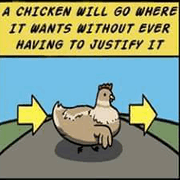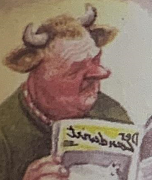|
Elukka posted:Do buffer and chain couplers, as used in Europe and some other places, have any benefits regarding the complexities detailed in that post? Not really. Knuckle couplers are stronger, safer, and faster (to couple and uncouple) than the British link and buffer system.
|
|
|
|

|
| # ? May 9, 2024 19:21 |
|
(This is from a UK heritage railway point of view) Knuckles are used within coach sets and usually screw link* used to connect loco to coaches. Some steam locos do have knuckles fitted. Gresley (an A4 like Mallard) definitely does as I had to take a course on its operation once. The screw coupling was the normal way of operating though. When not in use the knuckle hangs vertically downward. If needed the screw coupling can be moved to the side and the knuckle rotated up (and it's really, really heavy). If the screw coupling between loco and coach is not tightened sufficiently the passengers can feel a "shuttling" back and forth movement. The Q6 was notorious for this. *The coupling mounted on the loco is used to connect to passenger stock. If it's goods wagons the three-link on the wagon is used. There will be a reason for this but I don't know what it is!
|
|
|
|
I don't know why, but my brain broke staring at that screw connection. I think mainly because I'm trying to see how that thing would handle even a 50 car freight train on any kind of grade here in the states that wouldn't involve the screw shearing. I'm sure it is possibly fine, but just doesn't seem like something I'd want to trust. At least compared to the knuckle setup used here.
|
|
|
|
European goods trains have to contend with centuries old infrastructure meaning tight curves, small loading gauge and low maximum train length. They probably look like toy trains to you compared to American or Australian trains. Nevertheless the there's an EU project to introduce an automatic coupler for goods trains which would also connect air and electric connections. 2030 is the target to have rolling stock converted, and it will be some kind of Scharfenberg coupler.
|
|
|
|
Watch the locomotive too.
|
|
|
|
Grim Up North posted:European goods trains have to contend with centuries old infrastructure meaning tight curves, small loading gauge and low maximum train length. They probably look like toy trains to you compared to American or Australian trains. Yeah. I wrote a big-rear end post about this from the point of brakes (or British freight trains' lack thereof), here. But the same applies to couplings - once your entire national transport and industrial infrastructure is based around a standard, there's a massive disincentive for that standard to change, even if there are now technically better systems out there. Especially when all that infrastructure is owned by thousands of separate private companies, each seeing no real benefit to investing in improvements individually. It's no good one colliery investing in a fleet of 40-ton bogie hoppers with Westinghouse brakes and buckeye couplers if the railway its connected to doesn't have any locomotives that can couple, pull or stop those wagons and the port the coal is going to doesn't have the equipment to mechanically unload the hoppers. JuffoWup posted:I don't know why, but my brain broke staring at that screw connection. I think mainly because I'm trying to see how that thing would handle even a 50 car freight train on any kind of grade here in the states that wouldn't involve the screw shearing. I'm sure it is possibly fine, but just doesn't seem like something I'd want to trust. At least compared to the knuckle setup used here. Freight trains in the UK didn't even use screw couplers. They originally used three-link chain couplers, which were 'loose' (a lot of slack between each wagon). That stopped the in-train forces building up and overwhelming one coupling, since the wagons were free to move about and run slack in and out individually. With no continuous brakes, the skill of the guard in the brake van was to use enough braking force to keep most of the couplings loaded or even tight (but not too tight), and similarly the driver had to know when to apply and take off power (and how quickly). Every wagon basically went along the rails as a semi-independent entity, under only indirect control. On uphill gradients all the couplings would go tight and the weight of the train would come on the first wagon and the chain between that wagon and the loco, again the skill was in getting some tension on the couplings before you hit the grade and gently applying positive power with the loco so that coupling took up the weight gradually rather than as a shock load. But for all that broken couplings were a procedural hazard that was part of normal freight operations for about a century - that's why trains had brake vans at the rear and why lines with gradients were well-served with catch points and derailers. The other hazard was that if the couplings went too slack (if the train went downhill and the guard didn't keep enough brake force at the rear, or if the engine driver was too eager with the steam brake) the chain could become unhooked. Mineral trains were frequently 60, 80 or even occasionally 100 wagons long, all on loose-coupled three-link chains and no continuous brakes. Until about the time of WW1 most mineral wagons had 'dumb' buffers (just blocks of wood, not hydraulic or sprung pads) and many didn't even have any sprung draught gear (the coupling hooks were just bolted straight to the wagon frame, which was usually wood). Two rigid axles and a 9-foot wheelbase was the standard, producing a wagon that could hold 10 tons of coal in a wagon that weighed about 5.5 tons empty. So even the longest mineral trains rarely got above 1500 tons all-up weight. And yes, as you'd expect from a train made up of wooden-framed wagons with four wheels, a short wheelbase, dumb buffers, no brakes and held together by bits of chain, the maximum speeds were very low - 25mph as an absolutely maximum, with many plodding along at 15mph between frequent stops to inspect the bearings; oh yeah, most of these wagons ran on plain bearings 'lubricated' by tallow and other animal greases, so even at 20mph hot boxes were frequent (another common source of broken couplings and derailments) and the rolling resistance of the wagons was huge, especially in cold weather. It's notable that when railway companies had a free hand, they used rolling stock very similar to that used in America and other more forward-looking railway industries. The LMS had a fleet of twin-bogie 40-ton gondola-type hoppers that they used for internal traffic to carry coal to its own electric power stations, and as early as the 1900s the LSWR had developed a design of all-steel vacuum-braked twin-bogie ballast hopper that was so good that it was perpetuated right through to the end of BR and is still used today. The NER was able to use its monopoly over the coal-producing regions of County Durham to standardise on a type of 20-ton wooden-bodied bottom-drop hopper for coal, which the LNER developed into a 21-ton steel-bodied hopper. Dumb buffers and grease boxes remained common until well into the 1930s but after British Railways was formed all the wagons on the system came under single ownership. BR set up an 'Ideal Wagons Committee' to review the condition of its stock (about 1.5 million wagons and vans of various sorts), to decide which designs of wagon inherited from the private companies to continue and to draw up new standard types and features for future construction. This basically led to virtually all the ex-private owner wagons being hauled straight to the scrapyard. The bulk of the remainder were (slightly) more modern inter-war designs with a 10-foot wheelbase, steel frames, hydraulic buffers, draught gear and 'instanter' couplings, where the centre link in the chain had a triangular shape so it could be laid 'long-ways' to work like the old loose-coupled three-link chain or 'upright' to shorten the chain and bring the buffers into contact. These were permitted to run at up to 35mph in the 'loose coupled' configuration or up to 65mph if the coupling was in the short position. Just under 10 per cent of the wagon stock that BR inherited was fitted with continuous brakes, but as a result of the Wagons Committee an intensive programme through the 1950s saw virtually all the vans, flatcars and non-mineral open wagons retro-fitted with vacuum brake gear. New-build of general-purpose open wagons basically stopped and nearly all new freight wagons were brake-fitted. The exception was mineral wagons, which had to be unfitted for operational reasons (collieries, docks and other industrial handling gear couldn't handle wagons with brake gear). So mineral trains still plodded along at 20mph with rakes of unfitted loose-coupled 16-ton box wagons. By the 1960s the classic British goods train consisted of the front portion made up of vans, container-carrying flat-wagons and the occasional general-purpose open wagon, all fitted with vacuum brakes under the control of the driver on the loco and the rear portion made up of unfitted mineral wagons, tank wagons, bolster/machinery flat-wagons and the odd older van or GP wagon under the control of the guard in the brake van. The ratio of the braked and unbraked portion determined how fast the train could run - 35mph if the braked portion was only a few wagons, up to 65mph if the train was nearly all braked and all the wagons had instanter couplings and they were all in the short position. Then the Beeching-era reforms came along, general merchandise goods trains were virtually eliminated entirely from the network within a decade and BR standardised on long-wheelbase rolling stock with air-brakes forming single-purpose block trains running from point to point. As ever the exception was coal and mineral traffic, which remained stuck in the 1830s with rakes of short-wheelbase unbraked loose-coupled 16T wagons trundling around bits of the network until the 1980s.
|
|
|
|
I knew British railways were a bit technologically backwards but that's crazy. Thanks for the effort post.
|
|
|
|
Disgruntled Bovine posted:Not really. Knuckle couplers are stronger, safer, and faster (to couple and uncouple) than the British link and buffer system. Buffer and chain couplers are easier to tighten though. The lack of slack is an advantage in passenger services where a smooth ride is a bigger priority than easy marshalling and maximum coupler load.
|
|
|
|
Disgruntled Bovine posted:I knew British railways were a bit technologically backwards but that's crazy. Thanks for the effort post. While they undeniably were technically backward in some respects with regard to rolling stock (couplings and brakes especially), it's important to remember that whatever the shortcomings it worked. The British railway system at its peak moved a quite astounding volume, rate and variety of goods and people at a frequency and density not found on the same scale anywhere else on the globe. And remember that at the same time there were mineral trains creeping along with what were essentially 18th century farm carts held together by bits of chain and pulled by locomotives of a design not really changed since the 1850s, the companies were producing some of the most technically advanced passenger locomotives going, and running passenger services that included the fastest point-to-point timetabled service, the fastest average speed timetabled service and the longest non-stop timetabled service in the world. It's just a case of what the system and everyone in it was used to. For instance, just as the use of buffers, chains and handbrakes boggles the American railroading mind, so does the fact that train-order operation was still widely used on US railroads into the 1970s boggle those used to British railway practise. Arranging traffic by timetable and exchanging bits of paper with written orders on was phased out in Britain by the end of the 1870s because it had proved so dangerous, and everything from then on was done by signals, absolute block or token control. The condition of the permament way on many bits of the American rail system has been a continual source of horror for British observers pretty much forever, as has the fact that it's not properly fenced off or separated from other rights of way. Different conditions, different priorities, different business cases, different conventions, different practices, different legislative and commercial environments. They each worked (and work) for what they're required to do.
|
|
|
|
the UK had arguably the best public information ads about not sneaking onto the railway right of way (because you'll die or be horribly maimed) but it's just my luck I can't remember any of them
|
|
|
|
I have my final on track assessment in the next couple of weeks. No dramas so far, except isolating doors that fail because drunk idiots hold them open. Last week I was taking an empty back to our northern depot and was coasting through the second to last (dead/closed/dark) station at about 90 when I saw movement between the pillars. Someone running to towards the platform. I couldnt do anything but whistle. By the time it sounded, the shadow revealed itself to be some dumb girl taking a selfie with my train on her phone on the wrong side of the yellow line. She loving shat her self when she heard the horn, but to be fair so did I. Not as much as I am making GBS threads myself about fault finding in front of an assessor...
|
|
|
|
ChickenOfTomorrow posted:the UK had arguably the best public information ads about not sneaking onto the railway right of way (because you'll die or be horribly maimed) but it's just my luck I can't remember any of them Metro Trains in Melbourne, Victoria, Australia did a cartoon and a game called "Dumb Ways To Die." My guess is that the game has had well over 10 million downloads. The YouTube Video has 223,676,928 views: https://www.youtube.com/watch?v=IJNR2EpS0jw Love the jingle VideoGameVet fucked around with this message at 20:46 on Oct 22, 2021 |
|
|
|
The superglue dude rocking back and forth during the chorus kills me every single time.
|
|
|
|
lilbeefer posted:I have my final on track assessment in the next couple of weeks. No dramas so far, except isolating doors that fail because drunk idiots hold them open. Just remember to swap out the red disk for the yellow one. My trainee is doing his fault finding assessment today... He'll be fine. If it's any consolation, it's possible I'll be doing assessments on your class, and I'm (slightly) making GBS threads myself about that.
|
|
|
|
It's no "I'VE BEEN WAITING FOR THIS MOMENT FOR MONTHS" but the payoff is worth it: https://twitter.com/shrimp_delight/status/1452356854982459394
|
|
|
|
|
Theris posted:It's no "I'VE BEEN WAITING FOR THIS MOMENT FOR MONTHS" but the payoff is worth it: I didn't have a favorite loco before, but I do now.
|
|
|
|
Theris posted:It's no "I'VE BEEN WAITING FOR THIS MOMENT FOR MONTHS" but the payoff is worth it: "GB Railfreight kindly gave their permission to name locomotive 73962 after Dick Mabbutt, Brush Traction’s former group engineer who sadly passed away last year."
|
|
|
|
Ten days ago there was a 'minor' (as much as these things can be) crash at Salisbury when two trains going in the same direction on diverging lines collided with each other in a tunnel. No fatalities but some injuries, including 'life changing' ones for one of the drivers who was trapped in the cab of his train for some time. One of the DMUs ended up on its side. Early indications seem to suggest that the cause is a mix of low traction due to slippery (leaves on the line) conditions and some sort of signalling failure (either procedural or technical). A third train went through the junction just a minute or so before the collision, so a significantly worse crash was only narrowly avoided. This video (and others like it) have been doing the rounds of the recovery operation. Now, I'm not a rail professional in any way, but I always pictured recovery to be quite an involved and sophisticated thing involving cranes, winches, jacks, high-ratio pulley arrangements, hydraulic pistons and the like. Not "get a freight loco and a towing strap and pull really hard", like a scaled-up version of getting a car out of a ditch. Especially with lots of workers standing what seems to be very close to a towing strap being yanked by a 3300hp loco. https://www.youtube.com/watch?v=BsHXWUMsLdM Apparently it worked though, even if it did end up needing two locos. If you want to see and hear an EMD 645 get thrashed, this is a good video.
|
|
|
|
I'm not a rail professional either, but from the various videos I've seen and books I've read, recovery usually does involve cranes, jacks, sidebooms, and other heavy equipment. Of course, when you have a lot of equipment specialized in pulling heavy things, and you need to pull something heavy, sometimes you end up in a hammer/nail situation. See: https://www.youtube.com/watch?v=X3hgL4WpF60
|
|
|
|
metaxus posted:Just remember to swap out the red disk for the yellow one. Yeh fault and shed was easy. Mainline I have very soon and I am terrified. Edit: Lol it just clicked G'day Track Machine lilbeefer fucked around with this message at 08:52 on Nov 11, 2021 |
|
|
|
BalloonFish posted:Ten days ago there was a 'minor' (as much as these things can be) crash at Salisbury when two trains going in the same direction on diverging lines collided with each other in a tunnel. No fatalities but some injuries, including 'life changing' ones for one of the drivers who was trapped in the cab of his train for some time. One of the DMUs ended up on its side. Early indications seem to suggest that the cause is a mix of low traction due to slippery (leaves on the line) conditions and some sort of signalling failure (either procedural or technical). A third train went through the junction just a minute or so before the collision, so a significantly worse crash was only narrowly avoided. With most of the trains in a tunnel, access for cranes and equipment would have been more difficult than on open track.
|
|
|
|
lilbeefer posted:Yeh fault and shed was easy. Mainline I have very soon and I am terrified. Track Machine? My initials aren't IDV! Small world though. My trainee's assessment is on Monday, and his assessor is... Not my biggest fan. He's not really *any* female driver's biggest fan, and I actually have a suspicion he booked off to avoid taking over from me when I was DC the other day. Ah well, you'll be fine, and so will my trainee. No matter who you have, you're really just doing what you've already been doing, and they haven't spent all this time and effort for you to not get through it.
|
|
|
|
metaxus posted:Track Machine? My initials aren't IDV!  Im concerned about my assessor, more than I am my driving and knowledge.... I start my 3 days tomorrow lilbeefer fucked around with this message at 14:25 on Nov 11, 2021 |
|
|
|
lilbeefer posted:Small world indeed. I should have figured though after chatting with you during training So next time you see me, obviously you have to ask me if I have stairs in my house. Goddamn '04s. (Saying both of these things again makes me feel extremely old.)
|
|
|
|
metaxus posted:So next time you see me, obviously you have to ask me if I have stairs in my house. I can absolutely guarantee I will never ask this question unless change career to be a removalist lilbeefer fucked around with this message at 14:37 on Nov 11, 2021 |
|
|
|
lilbeefer posted:I can absolutely guarantee I will never ask this question unless change career to be a removalist Just say "All your tracks are belong to us"
|
|
|
|
I have absolutely no idea where else to post this, but… Did you know you can distinguish different models of DBAG Class 423 by sound? 
|
|
|
|
https://www.youtube.com/watch?v=NFLb1IPlY_k Trains! Maths! Graphs! Trains!
|
|
|
|
babyeatingpsychopath posted:https://www.youtube.com/watch?v=NFLb1IPlY_k A coincidence - I had never heard of these graph-form timetables before...until three days ago I watched this video: https://youtu.be/srpDHfuGzgs 'An Impression of a Day on the West Highland Railway' from 1960, which includes a shot of rows of desks with guys with comb-overs and circle-framed spectacles producing them (at 16:00 in the video). That film itself is a gem - the sort of weird mix of nerdy train-spottery detail, socialist realism, modernist art and slice-of-life drama that the BBC Film Unit seemed to specialise in in that period. I particularly like the contrasting voices - straightforward historical or geographical information read out in clipped, crystal-voweled BBC English, and all the operational stuff and 'local colour' and cultural commentary in Scots:  : "Garelochhead, then up to Douglas Summit." : "Garelochhead, then up to Douglas Summit." : "Loch Long, where tankers berth across from Argyll's Bowling Green. : "Loch Long, where tankers berth across from Argyll's Bowling Green.Poetry.
|
|
|
|
Huh, never head of water scoops before. But I guess that is because it wasn't employed much here in the states. Interesting idea though. https://www.youtube.com/watch?v=up96HiQyUVs
|
|
|
|
Hello Rail Friends, here is an article from Canada's globe and mail. https://www.theglobeandmail.com/business/article-how-bridging-finance-fooled-bay-street-and-hundreds-of-millions-of/ Now most of this concerns a finance firm that was horseshit and the fact that everybody was shocked! Shocked! That a firm that rich people believed in was a grift. But, midway through, there is a weird twist, basically because the CEO gets taken in by another grifter with really specifically weird railway dreams: quote:Around 2015, David Sharpe became enamoured by an obscure businessman named Sean McCoshen. Based in Winnipeg, Mr. McCoshen had a record of business failures and a vague, unverifiable résumé. Yet he’d remade himself as an adviser to First Nations communities and earned millions brokering loans for them. Much like with Jenny Coco, the professional relationship blurred into a personal one, with the Sharpes vacationing with Mr. McCoshen and his son.
|
|
|
|
JuffoWup posted:Huh, never head of water scoops before. But I guess that is because it wasn't employed much here in the states. Interesting idea though. Origin of the phrase 'A Jerkwater Town' used to describe an insignificant town/village. Does anyone say that anymore?
|
|
|
|
Here's a YouTube channel I came across recently. https://www.youtube.com/watch?v=gCfDQvrBGRw
|
|
|
|
Full Collapse posted:Here's a YouTube channel I came across recently. That is a cracking channel - I've often meant to post it in here myself. So much 1950s British Railways hubris! That video you linked to is a classic example - "It's only recently that it's been realised that this process of breaking up and re-forming trains is a century-old legacy, largely irrelevant to our contemporary economy. So the new aim is to get rid of marshalling yards all together!" This was in 1966, eleven years after the £1.2 billion 'Modernisation' Plan including building several huge new marshalling yards... Some other favourites: Second Report on Modernisation By this point the wheels were already coming off BR and Beeching was sharpening his axe. You wouldn't know it from this video, packed full of New Jerusalem, White Heat of Technology optimism, all set to a Handel brass band soundtrack. Eleventh Report on Modernisation - Nine years later and we've got to the stage of "actually, closing down railways is good because it creates loads of green space and you can use old engine sheds as music venues." Mishap - How to respond to accidents and incidents in 1958. This is York - A day's work at one of BR's big mainline stations in 1953. Spick and Span - How BR cleaned [was supposed to clean...] its coaches. Measured for Transport - How to move a high-voltage transformer through the Welsh mountains by rail in 1962. Little & Often - How to fire an LMS Black Five
|
|
|
|
BalloonFish posted:So much 1950s British Railways hubris! That video you linked to is a classic example - "It's only recently that it's been realised that this process of breaking up and re-forming trains is a century-old legacy, largely irrelevant to our contemporary economy. So the new aim is to get rid of marshalling yards all together!" This was in 1966, eleven years after the £1.2 billion 'Modernisation' Plan including building several huge new marshalling yards... Contrarian take: the Modernisation Plan - vastly over-simplified, natch - was just that, a modernisation plan of a railway that had literally been run into the ground the prior decade; because nobody's going to do more than bare keeping-things-moving upkeep, when shiny new track could be smashed to pieces overnight by the Luftwaffe, assuming the raw material was available in the first place. BR were given a sackful of cash, and they spent it on replacing decrepit infrastructure with expanded, modern infrastructure instead, swapping steam for faster diesel locos, and electrifying and re-signalling track, because these things were within their scope. Blaming hubris, or the gigantic freight yards, is a useful cudgel - but given that the entire logistics industry was upturned by containerisation, palletisation, ro-ro transport etc anyway, and that successive governments wanted to sweep away symbols of the old era and build motorways instead, it misses the mark imo. ...then came Beeching, bustitution, Serpell, Thatcherism, and Railtrack vs. the WCML, so maybe 'permanently imploding' is just the natural state of things anyway 
|
|
|
|
I think the main thing people point to as the disaster of the Modernisation Plan was the traction part - setting an absurdly aggressive schedule for dieselisation without appropriate native industry just led to a lot of crap locos that weren't fit for purpose. The other big element was that BR more than most railways didn't anticipate road haulage taking a lot of the short freight routes, and so were still building tiny freight locos like the Class 17s which were supposed to replaced steam tank engines like for like and we're effectively obsolete by the time they were built. It also didn't help that a lot of the replacements were themselves very poo poo, which led to stuff like 1st generation DMUs being used into the 90s and Class 37s still being used today, 60 years later. Meanwhile you end up with supposed stopgaps like the HSTs and Pacers in use for decades longer than they were supposed to be because nothing else decent could get built (for a whole host of reasons).
|
|
|
|
Nebakenezzer posted:Hello Rail Friends, here is an article from Canada's globe and mail. I was wondering why A2A suddenly stopped getting press in Alaska - they’re very well connected here, the vice chair is our former Lt Governor. Our congressional delegation was also promoting the whole thing since Trump gave it a cross-border permit.
|
|
|
|
Nebakenezzer posted:Hello Rail Friends, here is an article from Canada's globe and mail. JFC, all those people need to be drowned in acid, that whole thing was nothing but a massive set of scams. Very worthwhile reading.
|
|
|
|
Advent Horizon posted:I was wondering why A2A suddenly stopped getting press in Alaska - they’re very well connected here, the vice chair is our former Lt Governor. Our congressional delegation was also promoting the whole thing since Trump gave it a cross-border permit. I'm surprised (but maybe I shouldn't be) that these chucklefucks had a presence on the ground. I can only speculate the reason these dudes picked railways to connect a bunch of tiny villages is because they assumed that was the most ecologically friendly option? At the risk of starting a jihad with the aviation thread, I'd say the cheapest and most environmentally friendly way to link these communities is via air. Especially if you could get airships to do it. Lockmart's new heavy lifter is all developed and ready!
|
|
|
|

|
| # ? May 9, 2024 19:21 |
|
wolrah posted:Neither my girlfriend nor my housemate are train people or even gearheads but they both found it really cool to see up close, and then feel from in the house later that afternoon because we forgot it was coming until it was on top of us. Everything shakes so much more than the even a fast and heavy pass with the diesels. Oh hey, 765. I've seen it at it's home a couple times, they do an open house every year. I think this was from the 2017 one, but it's usually the same setup. Roll it out of the shed and keep a bit of steam up so they can blow the whistle and scare the gently caress out of people checking out the wheels.    It's got a weird history, the city originally wanted 767 as a display piece, but it was too deteriorated. So they got 765, changed the number and displayed it. Then later when it was decided to restore it, they changed the number back to its original.
|
|
|






























 so I could say that I finally figured out what this god damned cube is doing. Get well Lowtax.
so I could say that I finally figured out what this god damned cube is doing. Get well Lowtax.



